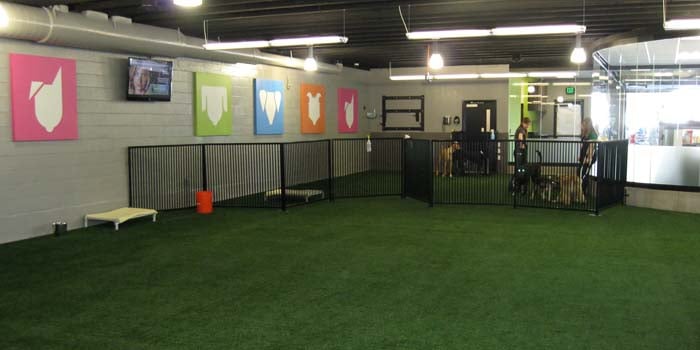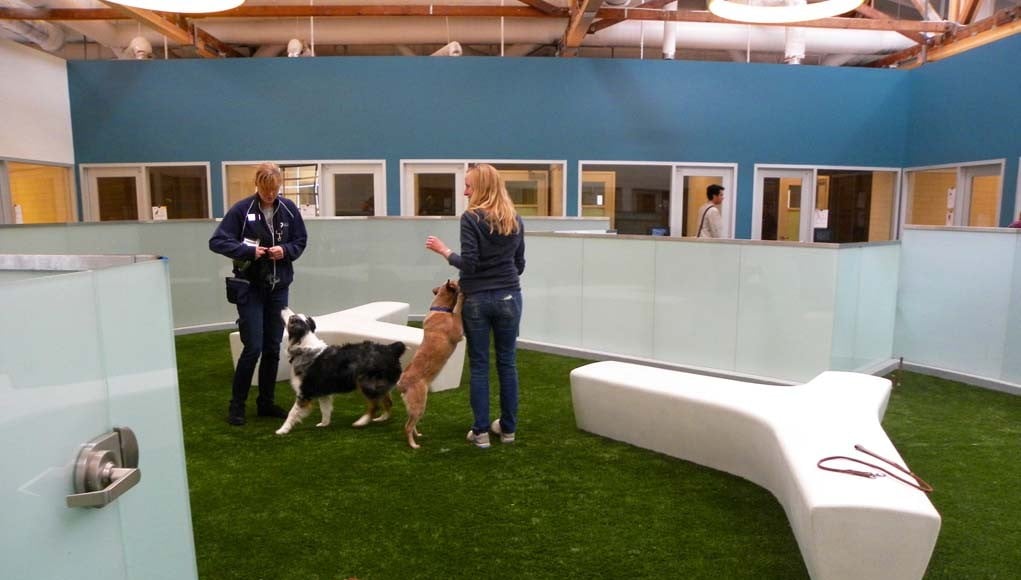As leash laws have become more restrictive and cities are becoming more and more crowded, many concerned dog owners are using indoor dog parks as a place to spend quality time with their pets. But just what is an “indoor dog park,” and what benefits can one bring to your city or town?
Outdoor dog parks are great if the weather is good, but what if it’s not? Indoor dog parks allow dogs and their owners to socialize in a climate-controlled, safe, indoor environment. Many of them also offer general educational classes, dog-training classes, doggy daycare, and special events.
Indoor dog parks have become increasingly popular. Pet owners are realizing the importance of socializing their dogs, and they are searching for dog-friendly environments that encourage such activities.
Indoor dog parks provide space for the off-leash exercise dogs' needs — space for them to run freely, rain or shine. If you are a dog lover and have thought about opening your own business, learning how to start an indoor dog park may be perfect for you.
Running your own business is certainly not an easy task. In fact, most small business owners work much more than 40 hours each week and they all wear many different hats.
If you open your own indoor dog park you will not only be responsible for the day to day business operations, but you'll also be the janitor, bookkeeper, social media manager and office assistant, along with a laundry list of other duties I'm sure.
How to Start an Indoor Dog Park

If you are prepared for the responsibilities of being a business owner, an indoor dog park is a great business to choose. No matter what region you live in, an indoor dog park will be of interest to the dog owners in your city. If you live in a colder climate or somewhere that gets a lot of rain, your establishment will probably be happily welcomed!
Research Your Market
Research what other indoor dog park owners are charging and what additional services they offer. Use this as a base to develop your rates. Visit indoor dog parks in other areas and ask about the day-to-day operation of the parks. If possible, speak with the owner to obtain business tips and advice that can assist with the planning of your indoor dog park.
RELATED: 10 Great Dog Business Ideas for Petreneurs
Investigate the level of interest for an indoor dog park in your proposed area. You could do this by visiting local pet supply stores, contact local veterinarians, and attend local pet expos. Speak with store customers, management, and personnel.
Learn as much as possible about the indoor dog park industry. Scope out indoor dog parks in other areas, research online informational websites, and browse through dog magazines and periodicals.
Research the Legalities
Contact your city’s municipal parks office or the local town hall to inquire about regulations for running an indoor dog park. Ask about any necessary permits or licenses required by the town. Look into any ordinances in your prospective town for noise restrictions that apply to barking dogs.
You should also consult with state or regional veterinary authorities regarding appropriate vaccinations and other measures that should be required for use in an indoor dog park. But whether required or not, you must make sure that all dogs who use your park are up to date on their vaccinations.
Some states require that a veterinarian provide a dog owner with proof of vaccinations for distemper, hepatitis, parainfluenza, parvovirus, bordetella, and leptospirosis. If you live in one of these states or regions, you will need to ask each customer for a copy for each dog and keep it on file.
If hybrid canines, dogs bred with other members of the Canidae family (wolf-dog and coyote-dog being two of the more common), are legal in your state, you must decide if they will be permitted in your indoor dog park. Your state or local government may have a vaccination requirement for these animals as well.
However, at present there is no approved vaccination against rabies for the wild side of these hybrids. Off-label use, the use of a drug for conditions for which it has not been officially approved, of the rabies vaccine for dogs may not provide effective coverage.
It is very important to research liability laws in your area and the insurance you will need to protect you and your indoor dog park from a lawsuit. For instance, what if one dog injures another dog while both are in your care and the owner of the injured dog sues you and your business? Paying one court verdict taken against you for an occurrence not covered by insurance could break you and your business.
RELATED: How to Start a Pet Business With Dogs
It is a good idea to consult an attorney about ways to separate you from your business in the legal sense so that if you lose a court case, you don’t have to pay from your personal funds to cover the verdict against you. An attorney can also help you choose insurance coverage that offers the most protection from liability issues for you and your business.
Establish Rules
Think in advance about the rules you will establish for your indoor dog park and be alert to conditions that might require you to modify them. Your initial rules could include things such as “no female in heat is allowed into the dog park to avoid fights among male dogs and unwanted pregnancies.”
The same goes for unneutered males as not only is there a risk of siring puppies accidentally, unneutered dogs can have social and behavioral problems. The high testosterone level of an unneutered dog can make him the target of aggression and harassment from other male dogs. Neutering can reduce the risk of marking, roaming, aggression, and mounting.
Another situation that begs for a rule is what you will do when one dog is aggressive with another. You will probably need a rule about bringing food or drink (for humans) or treats for dogs into the park. Try to think ahead of the situations you may encounter and what you can do in advance to defuse them.
Find a Location
Research the area in which you would like to construct your indoor dog park. Search for a location that includes a large, open, indoor space with a separate room that can serve as the office.
Locate property that is away from high traffic areas, industrial buildings, and busy roads if possible. Also, be sure your site is not located too close to any of your competitors.
Construct a Business Plan
The most important part in learning how to start an indoor dog park is developing a business plan that includes all aspects of your indoor dog park.
RELATED: How to Write a Dog Walking Business Plan
You need to include health regulations and guidelines, marketing strategies, turnaround time for profits, proposed rates, length of time necessary to prepare the grounds, startup costs, and day-to-day operating costs.
Develop a Marketing Strategy
Create business materials to distribute to the community. Include fliers, pamphlets, and business cards. Distribute informational materials to animal hospitals, pet supply stores, pet photographers, dog groomers, local veterinarians — any place you can think of that might have dog owners as clientele.
Advertise in doctor's offices, restaurants, stores, churches, schools, libraries, community centers, pet periodicals, local newspapers — any place you can reach dog owners. Use every way possible to get your indoor dog park info out into the community.
Become a member of local, real-world, and online pet associations and visit online message boards. Check to see if they will allow you to advertise your dog park business on their webpages.
Design a professional website for your dog park that includes the opening date, photos of the park, rates and fees for services, hours of operation, what your park will offer, and contact information.
Hire Employees
Hire employees to help run the indoor dog park. Depending on the size of the park, you may require anywhere from two to six employees at first. Hire enough staff to help with office work, waste removal, clean up, grounds maintenance, fee collection, speaking with dog owners, and generally overseeing the dogs.
What qualifications should you look for in an employee? Are there any certification requirements in your area for employees who work with animals? What do you need to require from an employee in order to limit your liability should anything happen?
This is another area in which you might want to consult an attorney. He should be able to help you develop a list of basic requirements for your employees or tell you that there is nothing in particular you need to look for in terms of legal or liability issues.
Learning how to start an indoor dog park could pay off well in the future and it would certainly be a fun job. Just make sure you know all the ins and outs, and be sure that you're responsible for any issues that may come up with clients, canines, or employees. Once you've got all your ducks, or dogs in this case, in a row you can begin creating your business plan.
















